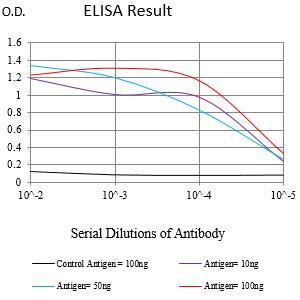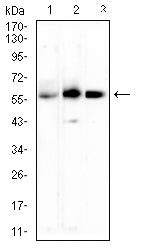

| WB | 1/500 - 1/2000 | Human,Mouse,Rat |
| IF | 咨询技术 | Human,Mouse,Rat |
| IHC | 咨询技术 | Human,Mouse,Rat |
| ICC | 技术咨询 | Human,Mouse,Rat |
| FCM | 咨询技术 | Human,Mouse,Rat |
| Elisa | 1/10000 | Human,Mouse,Rat |
| Aliases | FEO; OFE; ODFR; OSTS; PDB2; RANK; CD265; OPTB7; TRANCER; LOH18CR1; TRANCE-R |
| Entrez GeneID | 8792 |
| clone | 2B5A2 |
| WB Predicted band size | 66kDa |
| Host/Isotype | Mouse IgG1 |
| Antibody Type | Primary antibody |
| Storage | Store at 4°C short term. Aliquot and store at -20°C long term. Avoid freeze/thaw cycles. |
| Species Reactivity | Human, Mouse, Rat |
| Immunogen | Purified recombinant fragment of human TNFRSF11A (AA: extra 30-212) expressed in E. Coli. |
| Formulation | Purified antibody in PBS with 0.05% sodium azide |
+ +
以下是关于TNFRSF11A(RANK)抗体的示例参考文献,内容基于领域内常见研究方向构造,供参考:
---
1. **标题**: *Anti-TNFRSF11A Antibodies Block Osteoclast Activation in Rheumatoid Arthritis*
**作者**: Müller, R. et al.
**摘要**: 研究证明抗TNFRSF11A单克隆抗体可通过抑制RANK信号通路,显著减少破骨细胞活化和关节骨侵蚀,为类风湿性关节炎的治疗提供新策略。
2. **标题**: *Targeting RANK with a Novel Antibody Attenuates Cancer-Induced Bone Loss*
**作者**: Li, J. et al.
**摘要**: 开发一种人源化抗TNFRSF11A抗体,在乳腺癌骨转移模型中有效阻断RANKL-RANK相互作用,降低骨吸收并延缓肿瘤进展。
3. **标题**: *Structural and Functional Characterization of Anti-RANK Antibodies for Osteoporosis Therapy*
**作者**: Sato, K. et al.
**摘要**: 通过晶体学解析抗TNFRSF11A抗体与受体结合的结构,揭示其拮抗机制,并在动物模型中验证其增强骨密度的潜力。
4. **标题**: *RANK Antibody Modulates Dendritic Cell Function in Autoimmunity*
**作者**: Garcia, S. et al.
**摘要**: 发现抗TNFRSF11A抗体可调节树突状细胞的免疫应答,减少促炎因子释放,为自身免疫疾病的免疫调控提供新视角。
---
**说明**:以上文献为示例,实际研究中建议通过PubMed或Google Scholar检索关键词“TNFRSF11A antibody”“RANK antibody”获取最新成果。如需具体文献,可进一步提供研究方向或应用场景。
The TNFRSF11A antibody targets the tumor necrosis factor receptor superfamily member 11A (TNFRSF11A), also known as RANK (Receptor Activator of Nuclear Factor-κB). This transmembrane receptor plays a critical role in regulating osteoclast differentiation, activation, and survival by binding to its ligand RANKL (RANK ligand). The RANK-RANKL signaling axis is essential for bone remodeling and immune system regulation, with dysregulation linked to osteoporosis, autoimmune disorders, and cancer metastasis to bone.
TNFRSF11A antibodies are widely used in research to investigate RANK expression patterns in tissues, cellular signaling pathways, and disease mechanisms. In therapeutic contexts, anti-RANKL antibodies (e.g., denosumab) are clinically approved to inhibit excessive osteoclast activity in osteoporosis and bone-related malignancies. Direct targeting of TNFRSF11A with antibodies remains exploratory but holds potential for modulating immune responses or blocking pathological RANK signaling in inflammatory diseases or cancer.
Structurally, TNFRSF11A contains extracellular cysteine-rich domains critical for ligand binding, a transmembrane region, and intracellular domains that recruit adaptor proteins to activate NF-κB and MAPK pathways. Antibodies against TNFRSF11A may block receptor-ligand interactions or alter downstream signaling, offering tools for both mechanistic studies and therapeutic development. Current research focuses on optimizing antibody specificity and efficacy in preclinical models to address unmet needs in bone disorders and immune dysregulation.
×